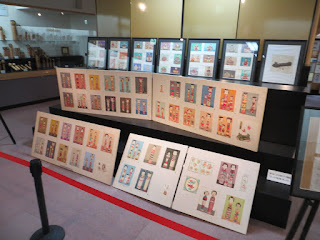 |
| Poster for the Rokuro Matsuri. |
Following the Michinoku Kokeshi Festival on 4 October last year (2014) we spent the rest of the day in Yamagata City, which is also where we spent the night. We got up the next morning feeling refreshed, grabbed some breakfast to go at a nice bakery, and then got on the highway for the other major event that weekend -- the the 26th annual National Traditional Kokeshi Lathe Festival 全国伝統こけしろくろまつり, or Rokuro Matsuri held at the Miyagi-Zao Kokeshi Kan みやぎ蔵王こけし館 near Togatta Onsen 遠刈田温泉. Rokuro means "lathe" in Japanese, and Togatta is one of the major kokeshi homelands, so suffice it to say this festival is an important one. As I mentioned in a previous blog the Rokuro Matsuri is typically held on the exact same weekend as the Michinoku Kokeshi Festival so we were never able to make it until this year. In the next couple of entries I'll show what we saw, but I did want to point out that one reason this festival is more challenging to
attend than Michinoku is that it's only accessible by car. Furthermore, as we shall see below the route will take you on small country roads in the middle of nowhere with limited signage, so a GPS is essential. That said the payoff is worth it, and if you can make it to the Miyagi-Zao Kokeshi Kan then you can also visit the Togatta Kokeshi Village and the workshops of various kokeshi makers located in town.
 |
| Going east on the Yamagata Expressway we got off at the Miyagi-Kawasaki exit. From there it became extremely rural. |
We headed due east through the mountains out of Yamagata Prefecture and into Miyagi Prefecture. Interestingly the prefectural border is actually marked in the middle of a long tunnel. As we headed back down towards sea level we exited at the Miyagi-Kawasaki exit and then found ourselves on rural prefectural roads going through rice fields and woods. Fortunately Naoko had her iPhone and trusty Google Maps, so we were pretty sure we were going the right way. If you're driving north or south on the Tohoku Expressway then get off at the Murata Interchange.
 |
| We turned at this old stone monument. |
The funny thing was that after exiting the highway Google Maps had us turn onto narrow, unmarked roads, so there was some guesswork involved as to whether or not we were on the correct road. But we could sense were going in the right direction and we got to see some beautiful countryside along the way.
 |
| At one point we were driving on this 1.5-lane country road. |
Early October is when the rice is ready for harvest, and Miyagi Prefecture is a big rice-producing region. As such we were treated to magnificent golden fields of ripe rice letting us know that fall was imminent.
After many turns and a pleasant drive through the countryside we finally entered Togatta via a bridge that has large kokeshis that appear to be standing guard. It is aptly named Kokeshi Bridge こけし橋. The kokeshis appeared to have been freshly painted and stood out nicely against the gray sky. Note: Once you reach this bridge you are almost at the Miyagi-Zao Kokeshi Kan.
 |
| Gateway to Togatta. |
 |
| The festival being held outdoors. |
By the time we arrived the festival was in full swing and since the weather was nice it was being held outside. There were a lot of cars and since the regular parking lot near the Kokeshi Kan was being used for the tents we had to park in the grace. But parking wasn't a problem and soon we were strolling up to our second major kokeshi festival in two days!
 |
| One of the festival banners. |
In upcoming blogs I'll show some photos of the festival and the Kokeshi Kan.














































